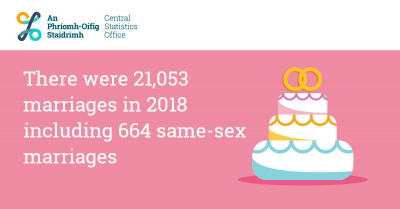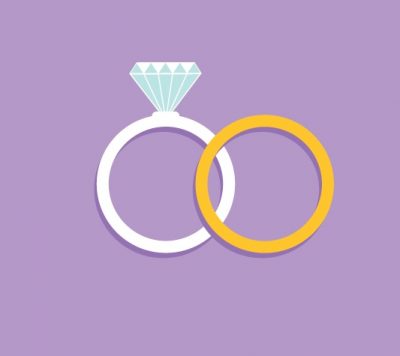
By Ann Marie Foley - 11 April, 2019

Almost half (49.2 per cent) of all opposite-sex marriages were Roman Catholic ceremonies, according to the Central Statistics Office (CSO) Marriage 2018 report. That compares with 52.8 per cent Roman Catholic ceremonies in 2017.
The report published on 10 April 2019 was based on data compiled from the marriage registration forms of all marriages registered in Ireland in 2018. There were 21,053 marriages in Ireland in 2018, including 664 same-sex marriages. The previous year (2017) there were 22,021 marriages in Ireland, including 759 same-sex marriages.
“The Roman Catholic ceremony was still the most popular choice among opposite-sex couples, with 10,027 couples opting for this ceremony,” said Carol Anne Hennessy, statistician. In 2017 some 11,219 couples opted for this ceremony.
The 2018 report shows that civil marriage ceremonies accounted for almost two-thirds (62.8 per cent) of same-sex marriages, while over a quarter (28.7 per cent) of opposite-sex couples chose a civil marriage ceremony.
David Quinn of the Iona Institute said that church marriage is becoming less popular in Ireland. “Our marriage rate is now on the lower end in the EU,” he told CatholicIreland.net. “It would be quite wrong to say marriage is in rude good health in Ireland. It is not.”
He added that the numbers of civil ceremonies compared with religious ones have been going up steadily over the last number of years as Ireland becomes more secular. Another factor in this is that some people who have a civil ceremony have divorced and are getting married for the second time so marriage in the Catholic Church is not open to them.
The current trend of having the marriage ceremony in the hotel or venue – and the reception in the same place – means that some people might not be simply rejecting a religious marriage ceremony but are choosing the convenience of just one venue.
 The CSO statistics show an increase in the number of couples choosing Humanist and Spiritualist Union of Ireland ceremonies. A Humanist ceremony was the choice of 1,766 opposite-sex couples and 121 same-sex couples in 2018, while 1,341 opposite-sex couples and 89 same-sex couples opted for a Spiritualist Union of Ireland ceremony.
The CSO statistics show an increase in the number of couples choosing Humanist and Spiritualist Union of Ireland ceremonies. A Humanist ceremony was the choice of 1,766 opposite-sex couples and 121 same-sex couples in 2018, while 1,341 opposite-sex couples and 89 same-sex couples opted for a Spiritualist Union of Ireland ceremony.
By comparison, a Humanist ceremony was the choice of 1,616 opposite-sex couples and 111 same-sex couples in 2017, while 1,083 opposite-sex couples and 76 same-sex couples opted for the Spiritualist Union of Ireland ceremony.
The average age for marriage ranges from over 30 years to just over 40. The average age of grooms in an opposite-sex marriage was at its highest to date at 36.4 years, while the average age of men in a same-sex marriage was higher, at 40.1 years.
The average age of brides in an opposite-sex marriage was slightly lower, at 34.4 in 2018, while the comparable age for women in a same-sex marriage was 38.7 years.
There is a continuing trend of people getting married at an older age, David Quinn stated. There are several reasons for this – they need to save a lot of money to buy a house or to have their dream wedding.
“Probably the biggest factor of all is that people now see their 20s as the decade of freedom, not of settling down,” said David Quinn. He points out that over the last 30 years the average age at which people marry has increased by 10 years.
“That has a big impact on fertility rates,” he added. “It is having an effect on the numbers of children being born.”
In 2013 there was the equivalent of 4.1 marriages for every 1,000 persons in the European Union. In the same year the crude marriage rate (number of marriages per 1,000 persons per year) for Ireland was 4.5. This was 6.4 in 1980 and is expected to decline to 4.0 in 2030, according to a recent study. These latest figures from the CSO stated that there is a crude (unadjusted) marriage rate of 4.3 per 1,000 population in Ireland in 2018.